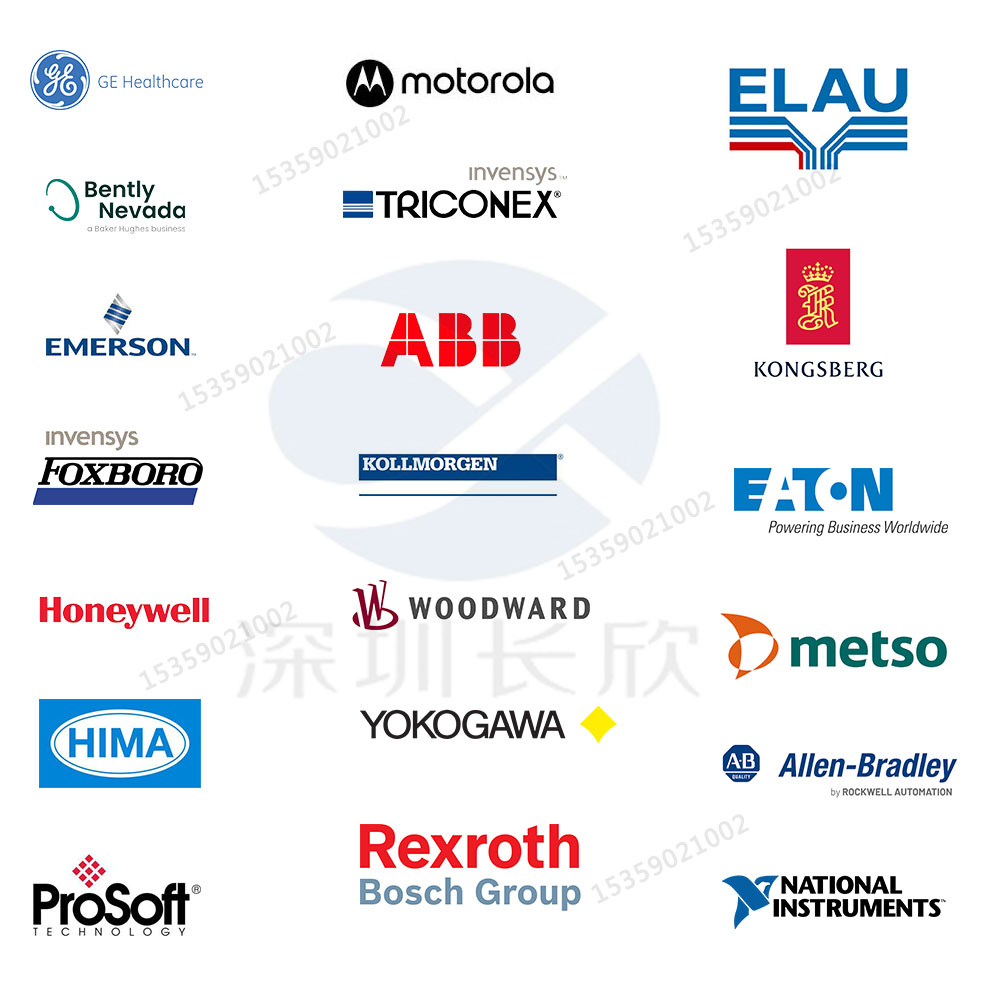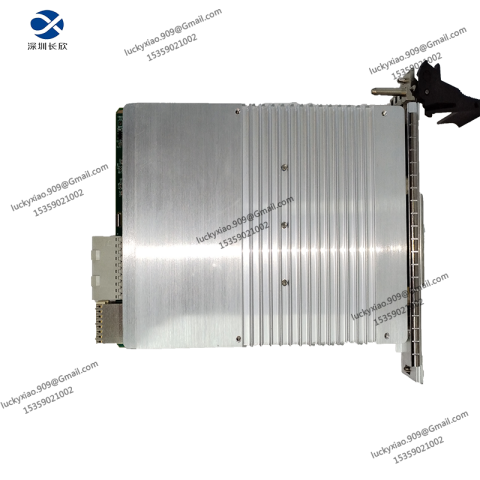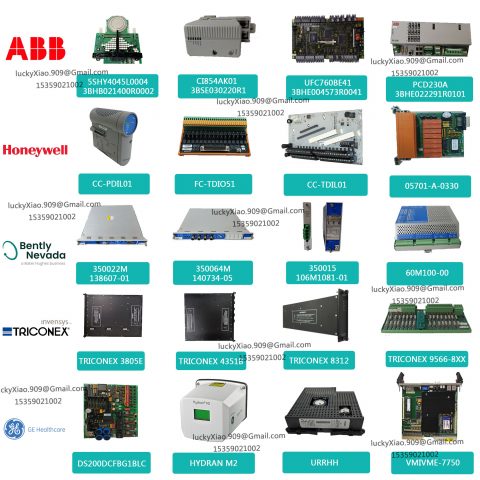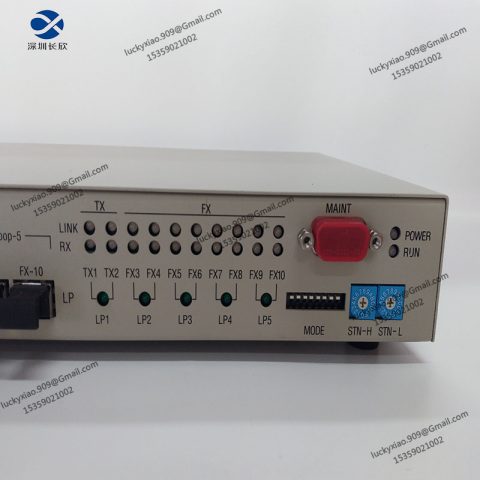Detailed Introduction to Bachmann AIO2881
1. Product Description
The Bachmann AIO2881 is a versatile, industrial-grade analog input/output (AIO) module developed by Bachmann Electronic GmbH—a leading provider of modular automation solutions for process and discrete manufacturing. Designed as a core component of Bachmann’s M1 automation system, this module integrates high-precision analog signal acquisition and control capabilities in a compact, rugged package, serving as the critical interface between field sensors/actuators and the central controller.
Tailored for industries requiring reliable analog signal processing, the AIO2881 excels in key scenarios:
- Process Manufacturing (Chemical, Pharmaceutical): Converts analog signals from pressure, temperature, and flow sensors into digital data for the controller, while sending analog control signals to valves, pumps, and dosing systems—ensuring precise regulation of reaction conditions;
- Power Generation & Distribution: Monitors generator output voltage, transformer temperature, and grid frequency via analog inputs, and controls voltage regulators or load switches via analog outputs to maintain grid stability;
- Industrial Machinery (CNC, Robotics): Acquires analog feedback from encoders (position, speed) and torque sensors, then sends analog control signals to servo drives—enabling smooth motion control and high-precision machining;
- Building Automation (HVAC, Energy Management): Collects analog data from temperature, humidity, and CO₂ sensors, and controls heating/cooling valves or fan speed regulators to optimize energy efficiency and indoor comfort.
With its high noise immunity, wide operating temperature range, and modular design, the AIO2881 delivers consistent performance in harsh industrial environments (e.g., high electromagnetic interference, temperature fluctuations) and seamlessly integrates with Bachmann’s M1 controller family—providing a scalable, cost-effective solution for analog signal processing in complex automation systems.
2. Product Technical Specifications
The AIO2881’s specifications are optimized for industrial analog signal processing, emphasizing precision, reliability, and flexibility. Key parameters are organized into intuitive categories below:
2.1 Analog Input (AI) Capabilities
|
Parameter
|
Specification
|
|
Number of Channels
|
8 differential analog input channels (configurable per channel)
|
|
Input Signal Types
|
– Voltage: ±10V, ±5V, 0-10V, 0-5V (user-selectable)- Current: 4-20mA, 0-20mA (loop-powered or active)- Thermocouples: J, K, T, E, R, S, B, N (with cold junction compensation)- RTDs: Pt100, Pt1000, Cu50 (2-, 3-, 4-wire configuration)
|
|
Input Accuracy
|
– Voltage: ±0.05% FS- Current: ±0.05% FS- Thermocouple: ±0.1°C (for K-type, 0-500°C)- RTD: ±0.05°C (for Pt100, -100 to 600°C)
|
|
Input Resolution
|
16-bit ADC (analog-to-digital conversion)
|
|
Sampling Rate
|
Up to 100 samples/second per channel (configurable via software)
|
|
Input Impedance
|
≥10 MΩ (voltage inputs); 250 Ω (current inputs, 4-20mA)
|
|
Isolation
|
Channel-to-channel: ≥500V AC (1 minute); Input-to-bus: ≥1kV AC (1 minute)
|
2.2 Analog Output (AO) Capabilities
|
Parameter
|
Specification
|
|
Number of Channels
|
4 analog output channels (configurable per channel)
|
|
Output Signal Types
|
– Voltage: ±10V, ±5V, 0-10V, 0-5V (user-selectable)- Current: 4-20mA, 0-20mA (sinking/sourcing configurable)
|
|
Output Accuracy
|
±0.1% FS (voltage and current outputs)
|
|
Output Resolution
|
16-bit DAC (digital-to-analog conversion)
|
|
Output Update Rate
|
Up to 100 updates/second per channel
|
|
Output Load Capacity
|
– Voltage: ≥1kΩ- Current: 0-500Ω (for 4-20mA)
|
|
Short-Circuit Protection
|
Yes (automatic current limiting; no damage to module)
|
2.3 Electrical & Power Specifications
|
Parameter
|
Specification
|
|
Power Supply
|
Powered via Bachmann M1 system backplane (no external power required)
|
|
Power Consumption
|
≤3W (typical, full load)
|
|
Noise Immunity
|
– Common Mode Rejection Ratio (CMRR): ≥120dB (50/60Hz)- Differential Mode Rejection Ratio (DMRR): ≥80dB- EMC Compliance: EN 61326-1 (industrial immunity)
|
2.4 Mechanical & Environmental Ratings
|
Parameter
|
Specification
|
|
Form Factor
|
Modular design for Bachmann M1 system rack
|
|
Physical Dimensions
|
36 mm (W) × 100 mm (H) × 160 mm (D) (compact size for high-density mounting)
|
|
Weight
|
~250 g
|
|
Operating Temperature
|
-25°C to +60°C (ambient); storage temperature: -40°C to +85°C
|
|
Relative Humidity
|
5% to 95% (non-condensing)
|
|
Vibration Resistance
|
10-500 Hz, 1.5 G (IEC 60068-2-6)
|
|
Shock Resistance
|
10 G (11ms duration, IEC 60068-2-27)
|
|
Protection Level
|
IP20 (module); IP54 (when installed in Bachmann M1 rack with front cover)
|
2.5 Compliance & Certifications
|
Parameter
|
Specification
|
|
Safety Certifications
|
EN 61010-1, UL 61010-1, CSA C22.2 No. 61010-1
|
|
EMC Certifications
|
EN 55032 (emission), EN 61326-1 (immunity)
|
|
Environmental Compliance
|
RoHS compliant (EU Directive 2011/65/EU)
|
3. System Introduction
The Bachmann AIO2881 functions as the “analog interface bridge” in Bachmann’s M1 automation system, integrating with field devices, controllers, and software to enable seamless analog signal processing. Below is its role in a typical industrial automation system architecture:
3.1 System Architecture
A complete automation system with the AIO2881 includes four key layers, designed for reliable signal flow and control:
- Field Device Layer:
-
- Analog sensors (e.g., pressure transmitters, thermocouples, RTDs) collect process data and send analog signals (4-20mA, ±10V) to the AIO2881’s input channels.
-
- Analog actuators (e.g., control valves, servo drives, variable frequency drives) receive control signals from the AIO2881’s output channels to execute physical actions.
- Interface Layer (AIO2881 Core Role):
-
- Signal Acquisition: The AIO2881 converts analog input signals from sensors into digital data via 16-bit ADCs. It performs signal conditioning (e.g., filtering, amplification) and error correction (e.g., cold junction compensation for thermocouples) to ensure data accuracy.
-
- Signal Output: The module converts digital control commands from the M1 controller into analog output signals via 16-bit DACs, sending precise control signals to actuators.
-
- Isolation & Protection: Channel-to-channel and input-to-bus isolation prevents electromagnetic interference (EMI) and voltage spikes from damaging the controller or field devices. Short-circuit protection on output channels safeguards the module and actuators.
- Control Layer:
-
- A Bachmann M1 controller (e.g., M1-CPU200) communicates with the AIO2881 via the system backplane. It processes digital data from the module, executes control logic (e.g., PID regulation), and sends digital control commands back to the AIO2881.
-
- The controller also handles module configuration (e.g., input/output signal types, sampling rates) via Bachmann’s Automation Studio software.
- Software & Visualization Layer:
-
- Bachmann Automation Studio software provides a unified platform for configuring the AIO2881 (e.g., channel settings, scaling), programming the M1 controller, and monitoring analog signals in real time.
-
- Operators can view analog data (e.g., temperature trends, valve positions) via HMI (Human-Machine Interface) software or SCADA systems, and adjust control parameters (e.g., setpoints) to optimize process performance.
3.2 System Advantages
- High Precision & Accuracy: 16-bit ADC/DAC resolution and ±0.05% FS input accuracy ensure reliable measurement and control—critical for applications like pharmaceutical manufacturing or precision machining.
- Flexible Configuration: Per-channel configurable signal types (voltage, current, thermocouple, RTD) eliminate the need for multiple specialized modules, reducing system complexity and cost.
- Rugged Industrial Design: Wide operating temperature range (-25°C to +60°C), high noise immunity, and vibration resistance make the AIO2881 suitable for harsh environments (e.g., factory floors, power plants).
- Seamless Integration: Optimized for Bachmann’s M1 system, the module connects directly to the backplane without additional wiring, enabling fast installation and scalable system expansion (e.g., adding more AIO modules for additional channels).
- Easy Maintenance: Diagnostic features (e.g., sensor 断线 detection, overrange alerts) and hot-swappable capability (when used with M1 rack) minimize downtime for maintenance or repairs.
3.3 Typical Application Example: Chemical Reactor Control
In a batch chemical reactor system, the AIO2881 plays a pivotal role in regulating reaction temperature and pressure:
- Field Layer: A Pt100 RTD (temperature sensor) sends a resistance signal to the AIO2881’s input channel 1, and a pressure transmitter sends a 4-20mA signal to input channel 2. A control valve (actuator) receives a 4-20mA signal from the AIO2881’s output channel 1 to adjust coolant flow.
- Interface Layer: The AIO2881 converts the RTD resistance signal to a digital temperature value (e.g., 85°C) and the pressure transmitter’s 4-20mA signal to a digital pressure value (e.g., 6 bar). It sends these values to the M1 controller via the backplane.
- Control Layer: The M1 controller compares the measured temperature (85°C) to the setpoint (90°C) and executes a PID control algorithm. It sends a digital command to the AIO2881, which converts it to a 4-20mA signal (e.g., 12mA) to open the control valve slightly, increasing coolant flow to raise the temperature.
- Software Layer: Operators monitor the temperature and pressure trends via Automation Studio or an HMI, and adjust the setpoint if needed. The AIO2881’s diagnostic features alert operators if the RTD is disconnected or the pressure exceeds the measurement range.
4. Key Features & User Benefits
- Sensor Diagnostics: Built-in detection for sensor 断线,short-circuit, and overrange conditions helps identify issues early, preventing process disruptions.
- Cold Junction Compensation: Automatically compensates for temperature variations at thermocouple connection points, ensuring accurate temperature measurement without external hardware.
- Scalable Channel Count: The M1 system supports up to 32 AIO2881 modules per rack, allowing users to expand analog I/O capacity as process requirements grow.
- Backplane Communication: High-speed backplane communication (up to 100 Mbps) ensures real-time data transfer between the module and controller, critical for fast-response control applications.
Conclusion
The Bachmann AIO2881 is a reliable, flexible analog I/O module that delivers high-precision signal processing for industrial automation systems. Its compact design, rugged construction, and seamless integration with Bachmann’s M1 ecosystem make it an ideal choice for process manufacturing, power generation, industrial machinery, and building automation. By bridging the gap between field devices and controllers, the AIO2881 enables precise, efficient control of analog processes—helping businesses improve product quality, reduce downtime, and optimize operational costs. Whether used in a small-scale machine or a large-scale process plant, this module is a trusted component for industrial analog signal processing.





_副本-480x480.jpg)






There are no reviews yet.